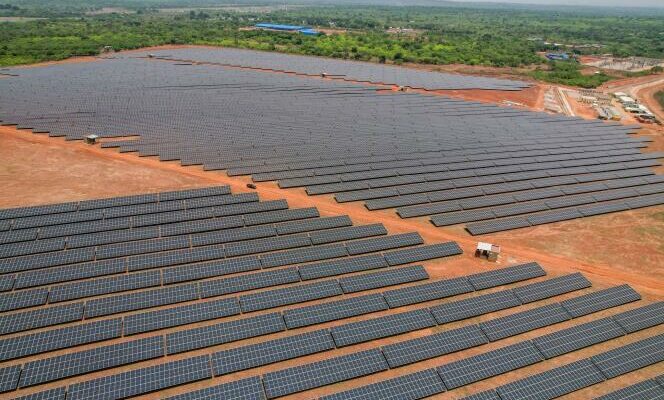In Boundiali, in the north-west of Côte d’Ivoire, a new type of farm, covered in glass and aluminum, stretches out among the cotton fields. On Wednesday April 3, the country inaugurated its first photovoltaic power plant, or at least the first phase of the project. Within a year, nearly 150,000 solar panels planted on 78 sunny hectares should generate 80 megawatts of electricity (MW).
Largely co-financed by the German development bank KFW and the European Union for a total cost of 47 billion CFA francs (71.6 million euros), the Boundiali solar power plant should enable Côte d’Ivoire to “providing electricity to more than 430,000 people and saving the equivalent of 60,000 tonnes of CO2 per year “, welcomes the Minister of Mines and Energy, Mamadou Sangafowa Coulibaly.
For the authorities, the objective is twofold: complete the electrification of the country to connect all Ivorians to the network (94% of them have access to electricity today), but above all accelerate the energy transition in order to to respect the climate commitments made in 2021 by the State, namely an energy mix composed of 45% renewable energies and a reduction in greenhouse gas emissions of 31.4% by 2030 compared to 1990. Without giving up exploiting the hydrocarbon deposits discovered in recent years off the Ivorian coast.
A strategic role
Today, carbon-free energies represent 31% of the electricity produced in the country, according to official figures. The seven hydroelectric dams in service currently constitute the main alternative to the four existing thermal power stations. Among the many dams planned or already under construction, that of Gribo-Popoli (southwest) should be inaugurated in June and provide an additional 112 MW.
In solar too, work is increasing. The brand new Boundiali power plant will soon no longer be the only one of its kind, according to the Minister of Energy, who cites around ten towns in which photovoltaic farms will appear shortly, mainly in the north. from the country. In five years, “the share of solar energy will be 9% », he predicts.
In this energy diversification strategy, biomass is not neglected. Several initiatives are emerging, including those led by the company Biovea Energie, which, in July 2023, launched the construction of a power plant in Aboisso (south-east) powered by oil palm residue. Scheduled for 2025, the plant should be, with its expected 46 MW, “the largest in the West African sub-region”, rejoices the government. Projects for the reuse of cotton stalks in Boundiali (25 MW) or cocoa pods in Gagnoa (20 MW) are also being studied.
All these initiatives, completed and ongoing, are part of the 2014-2040 Production Master Plan, the objective of which is to ensure an electricity production capacity of 4,600 MW. “Today we are at 2,907 MW of installed power”reports Ehouman Kalifa, Director General of Energy at the Ministry of Mines, Oil and Energy.
Present during the inauguration in Boundiali, the Prime Minister, Robert Beugré Mambé, recalled the intention of President Alassane Ouattara to “make Côte d’Ivoire the energy reservoir of West Africa”. The country already plays a strategic role in the sub-region by selling nearly 10% of its electricity to its neighbors, led by Ghana and Mali.
Offshore megs
But to maintain this status as a supplier country while meeting the growing needs of the population and industry, it is difficult to do without the colossal oil and gas resources that the country has. The Baleine and Calao offshore mega-deposits, discovered respectively in September 2021 and March 2024, constitute a considerable windfall, enough to provide the Ivorians with “abundant and affordable energy”, promises the government. Oil exporter in a few years, when production is running at full speed, Côte d’Ivoire intends to join the Organization of the Petroleum Exporting Countries (OPEC) and make the extractive industry the second engine of its growth after ‘agriculture.
Follow us on WhatsApp
Stay informed
Receive the essential African news on WhatsApp with the “Monde Afrique” channel
Join
“With current development needs, we cannot give up fossil fuels”, concedes Wanignon Ferdinand Fassinou, lecturer in energy policies at the Félix-Houphouët-Boigny University in Abidjan. The development of the mining industry, agricultural resource processing plants (cocoa, cashew nuts, rubber trees) and even the transport network are all sectors which illustrate this dependence on cheap carbon-based energies.
Especially since certain renewable energies, such as wind or solar, are by nature intermittent and cannot cover all needs on their own. Without wind or sun, it is thermal combustion that gives light. For Côte d’Ivoire, as in most emerging countries, renewable energies will therefore be added to those of fossil origin rather than replacing them.
Despite the warnings of several international environmental NGOs, technological innovation is seen as a possible link between decarbonization and hydrocarbon production. This is in any case the intention of the government, which would have received from the Italian oil group Eni, co-operator of the Baleine and Calao deposits with the Ivorian company Petroci, guarantees for “minimize greenhouse gas emissions during production”. Using technologies capable of capturing CO2 issued, Baleine should be the first hydrocarbon project “ zero greenhouse gas emissions in Africa”, assures the Italian major.
